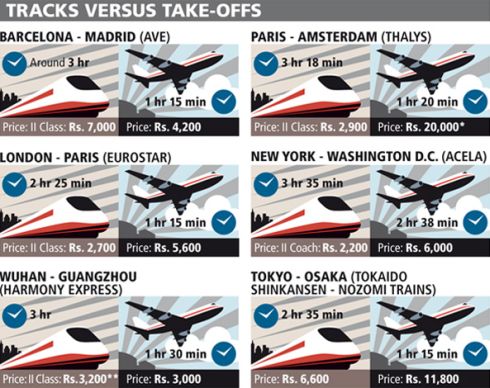Whether you like it or not a high-speed rail system between Malaysia and Singapore is bound to happen, sooner or later. Except for ex-PM Mahathir and a bunch of racist politicians, it seems nobody would reject a shorter travelling time and a closer relationship with Singapore. Forget about Mahathir‘s lopsided opinion about Singapore as history will show how his past administration was no match to Lee Kuan Yew’s landmark transformation of the tiny island.
Perhaps Mahathir is best compared to his buddy ex-President of Indonesia Suharto in terms of corruption. Nevertheless by the time a high-speed rail system connecting Malaysia-Singapore is ready for public use, Mahathir would not be around to try it, not that he wants to as long as Lee Kuan Yew is still alive on the other side of the island. Corruption aside, the plan for travellers to make a day-trip via high-speed train from Malaysia, particularly Kuala Lumpur, to Singapore is not something new.
The idea was once mooted by YTL many years ago but that plan still remained on the drawing board. YTL Corporation Berhad (KLSE: YTL, stock-code 4677) Francis Yeoh’s proposal was shot down by the Economic Planning Unit (EPU) on Apr 2008 in what appeared to be a very risky financial model that the government has to bear as the RM8 billion (US$2.5 billion) proposal consists of many unknown grey areas such as land acquisition, environment impact and others.

Many commented that Francis Yeoh didn’t get the then PM Abdullah Badawi’s attention because Francis Yeoh was a crony of ex-PM Mahathir, who was in his de-tour in unseating Badawi. Now that Mahathir is pulling the string from behind Najib administration, would tycoon Francis Yeoh’s luck turn for the better? The recent ambitious ETP (Economic Transformation Programme) initiative brought back the idea of a high-speed rail system and if the Land Public Transport Commission and the Economic Planning Unit study is anything to go by, the idea could be transformed from drawing board to reality.
On paper the two-hours traveling on a high-speed railway between Kuala Lumpur-Singapore mega-project could easily exceed the estimated RM45 billion costs. But the traveling time could be as short as 90 minutes, depending on the number of stops, as can be seen from Taiwan’s high-speed rail system from Taipei to Kaohsiung which interestingly has a distance of 335.5km, similar distance between Kuala Lumpur-Singapore. And it would be fun working in Singapore earning the dollars but spending it in Malaysia.
If one can travel between the two cities within 90 minutes the economy impact would be tremendous, not to mention it would give airlines such as Malaysia Airline System’s (KLSE: MAS, stock-code 3786) and AirAsia Berhad’s (KLSE: AIRASIA, stock-code 5099) a run for their money. Who would waste 3 hours flying (excluding flight delays which are normal with AirAsia) if one could hop in to a high-speed train and reach Singapore or Kuala Lumpur in 90 minutes?

Now, if Najib golf partner had indeed succeeded in getting the RM500 million commissions from the Chinese authorities as alleged, then the China’s world fastest rail link could get a slice of the Malaysia-Singapore high-speed rail system project. China surprisingly took only 6-years what developed countries would have taken 30-years in high-speed railway technology. China’s super-high-speed train can go up to 394.2 kilometers / hour compared to Japan’s 243 kilometers / hour and France’s 277 kilometers / hour.


Recently South Africa Standard Bank and China signed a US$30 billion-deal to finance the construction of the first high-speed railway in South Africa. On July 15th 2010, Argentina signed a high-speed railway technology export contract worth of US$10 billion with China. In 2009, China signed an agreement with Russia and General Electric Co. of the United States to work together on high-speed railway construction. Altogether, China has registered 946 patents on domestically developed high-speed railway technology.

China’s trial during a dedicated 968-kilometer run between Wuhan and Guangzhou that clocked speeds of up to 394 km/hr (245 miles/hr) could be presented as a case-study to impress Malaysian government of its engineering capability. As we speak, I believe the Malaysian Cabinet has on his table the proposal from Changchun Railway Vehicles, the builder of 380A, the China and world’s fastest train.

The only question is: how much should the project marked up as part of the standard leakages for such a mega project in Malaysia. Will YTL get the lion share of the project or Najib’s cronies would be preferred main-contractors which time around.
Other Articles That May Interest You …
- ETP – Wishful Thinking Against Reality Hidden from You
- Bullet Train halted at drawing board, Cost is Silly High
- Are you a good Negotiator or a good money Spender?
- Windfall Tax – Punishment or Desperation for Money?
- Breakfast in KL and lunch in Singapore

|
|
September 27th, 2010 by financetwitter
|


|

|

|

|

|

|




























Would it not be better if the writer can make his/her point without pouring insults on the former premier of Malaysia? not that i like or care about him but just feel that insulting him is not called for here. Well maybe i am wrong